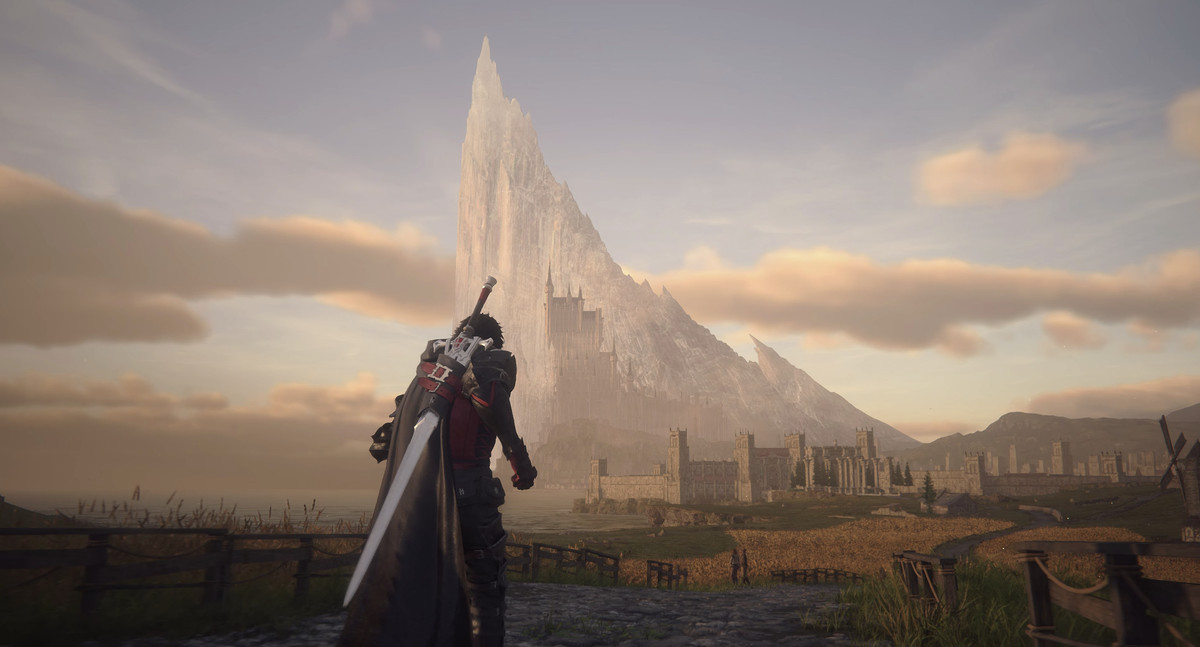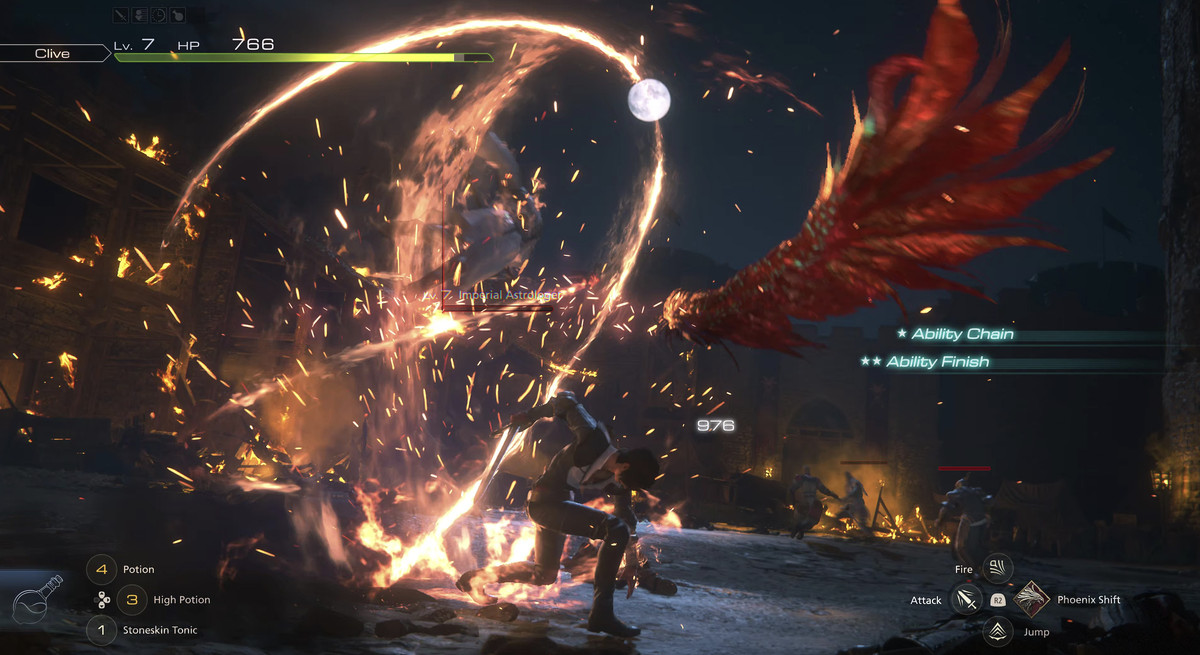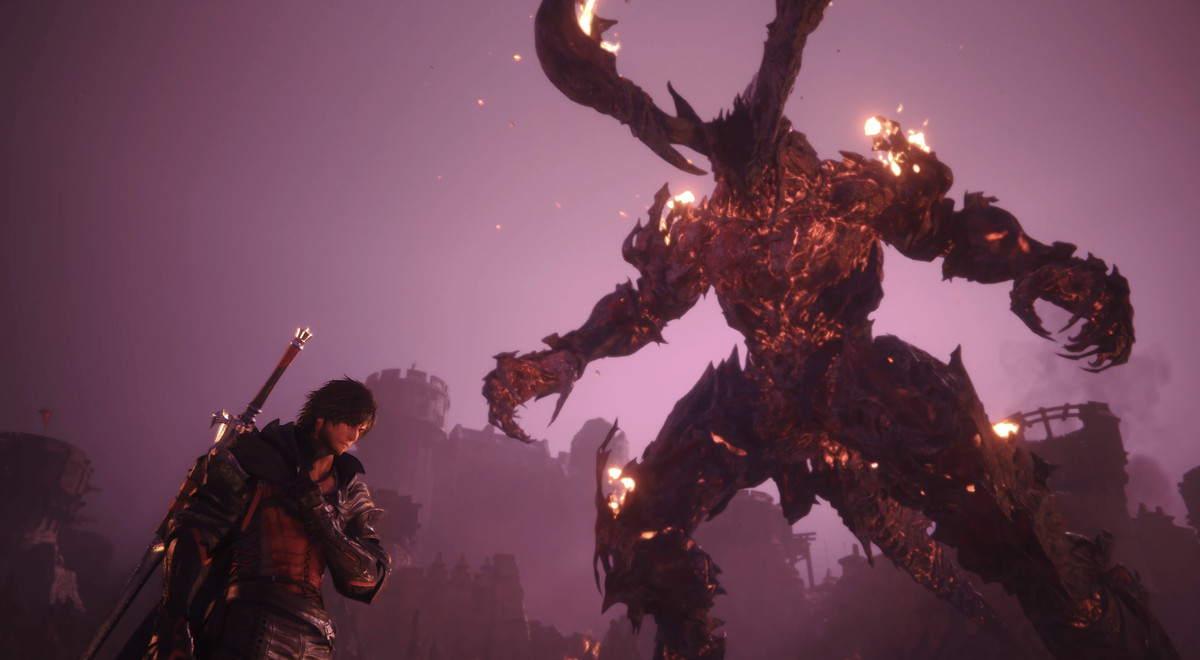After 16 mainline installments, it’s hard to say that any one thing defines the Final Fantasy series. There are certain immutable pieces of symbolism that must carry over from game to game — chocobos, Cid, moogles — but the shape in which they appear is always different. In my mind, I see it as a series of dials that get pushed up or down depending on who is in charge of each installment. Some people prefer the game when the angst dial is turned all the way up, and others want to see a little more volume on the dungeons or puzzles. Every Final Fantasy is someone’s favorite Final Fantasy.
Final Fantasy 16 will certainly be someone’s favorite Final Fantasy. It isn’t mine, as thrilling as it often can be. I gravitate toward the sweeping, melodramatic stories of Final Fantasy. FF16’s story is sweeping and plenty melodramatic, but it’s also boring and tedious, leaving me feeling like the game was wasting my time. What a shame that this is the story that accompanies the compelling combat design and encounters that I couldn’t get enough of.
Final Fantasy 16 is a fast-paced action game that begs to be played over and over again. You play as the main character Clive Rosfield, once a prince of a duchy and now an enslaved soldier, and you puppet this man from combat encounter to combat encounter between scripted scenes that drive the story forward and excursions to check out the side quests. Ryota Suzuki, the combat director for 16, also worked on Dragon’s Dogma and Devil May Cry, and it shows — not only in its electric combat, but also in the ability to replay every stage in pursuit of a higher grade.

Rather than summoning characters like Garuda or Shiva to fight for him, Clive is imbued with the elemental power of these Eikons. Eikons are the physical embodiment of the elemental powers of super-special magic users called Dominants (yes, they are all called Dominants all the time, and no, it never stops being funny). In the fiction of the world, only Dominants can summon the powers of or transform into Eikons, and there can only be one Eikon per element at a time.
Each unlocked Eikon gives you a new set of elemental powers to mix and match. You start off with the Blessing of the Phoenix, which lets you close the distance with an enemy instantly, as well as two other abilities, one that sets nearby enemies on fire and another that delivers a flaming kick to one enemy. These abilities are useful in combat not only to whittle down enemies’ health, but also to cause them to stagger, allowing you to whale on them while they’re temporarily incapacitated. These maneuvers are also gorgeously animated, incentivizing you to use them as much as possible.
The abilities bound to each Eikon are as varied as they are versatile; Garuda pulls enemies closer to you, while Ramuh gives you the ability to slow down time and target multiple enemies with a powerful bolt of lightning. Many unlockable abilities change the overall flow of combat. Will o’ the Wisps summons balls of fire that encircle Clive, continuously hitting any enemy that comes in range. Whirlwind, which you gain after unlocking Garuda, lifts several enemies into the air before slamming them into the ground. By the end of the game, you can fine-tune your ability loadout to make a veritable killing machine without equal. At the outset, I was a little anxious that the amount of customization would prove unwieldy — but by the time the credits rolled, my newfound power felt like second nature.

I approached each fight in 16 with the hunger of an unfed animal. No matter how much I disliked other aspects of the game, every single combat encounter rejuvenated me. Sometimes, when traversing the few open areas of the game’s map, I felt cheated if I beat wandering mobs of low-level enemies too quickly. I needed more: to see Clive leap and lunge from enemy to enemy, to hurl them up in the air, to drive my sword through them, to electrocute them, to set them on fire, to switch between these elements so quickly that the screen illuminated my surroundings with all the colors of elemental magic.
It’s fun even just fucking around, seeing what’s possible and how your combat abilities play off of one another. Once, while fighting a dragon, I summoned a ball of lightning that I could wallop with my sword to create even more chains of lightning. The dragon opened its mouth to breathe fire, and, low on health, I dodged out of the way, even if I desperately needed to kill this damn dragon before it killed me. I was in luck; the fire hit my lightning orb, activating its chain lightning and killing the dragon all the same. I shouted out loud in my empty apartment.
My favorite Final Fantasy games give me something I haven’t seen before, and 16 is awash in moments of dazzling spectacle. The boss fights in 16 are a kind of theme park ride: I fought a colossal Eikon on top of a mountain, stabbing its palm as it swiped at me. I transformed into Ifrit, an Eikon that looks like a demon consumed by flame, and turned my flaming fists on the technology of a long-lost precursor race. I fought a dragon and was launched into space, punching my enemy until it was dead, before falling back through the atmosphere. Even the quick-time events — an aesthetically pleasing but silly addition to most games’ boss fights — add to the thrills. These set-pieces made me feel downright powerful, providing moments of catharsis even in the midst of combat.

If every part of 16 was as good as its boss fights, this would be one of the greatest games of all time. But the scripted story is, frankly, boring. It isn’t that the characters are unlikable — I grew to like Clive through his romance with Jill, and found Cid to be a welcome reprieve from a bleak and unforgiving narrative. A lot of the banter between characters during missions also made the characters feel more whole. The world of Valisthea that these characters inhabit is the real issue, as is the narrative’s propensity to hurtle the characters from traumatic event to traumatic event with little rhyme or reason.
Final Fantasy 16’s plot is one of the more rote medieval fantasy tales this side of 1960. Although it takes clear and obvious inspiration from Game of Thrones, based on George R.R. Martin’s A Song of Ice and Fire series, it takes all the fantasy tropes that Martin was commenting on and plays them totally straight. The result is a story largely about white Europeans discovering that slavery is wrong for the very first time in their lives.
As far as I can tell, every nation of Valisthea depends on slavery to make its economy function. Magic users, known as Bearers, are tested and enslaved at birth and given a face tattoo so that everyone can always identify them. They are worked cruelly until they die, are bought and sold, and aren’t considered human beings by non-magic users. Cid recruits Clive with the noble goal of freeing the slaves, but this comes with the tedium of you, the player, having to watch Clive come to the realization that slavery is wrong. It’s a little uncomfortable to play as a guy who only realized it is wrong to own a human being about five minutes ago, even if the game goes to great lengths to show you that he was always nice to the slaves.
This slavery subplot doesn’t ever make a lot of sense, even though explaining the ins and outs of this system of slavery takes up the bulk of the game’s first dozen hours. But never fear: This extremely uncomfortable and poorly handled subplot abruptly disappears in favor of an end-of-the-world-level threat. The political situation of the nations of Valisthea ceases to have any consequence.

Despite how long it takes to set up the lore surrounding the magic system in the game’s many cutscenes, Final Fantasy 16 isn’t very interested in the politics of slavery or enslaved peoples, nor does it seem interested in its story in general. Disappointingly, some of the finer plot details are relegated to the in-game wiki; the emperor of the French-flavored nation of Sanbrecque keeps menacing another with a very specific flower, and you only ever learn that that flower is the literal symbol of the nation of Sanbrecque if you read a text entry in an optional feature. That such a potent piece of symbolism and character motivation is consigned to an optional menu is a testament to the game’s priorities; the action is the focus, the story a distant second.
Worst of all, the plot is diametrically opposed to the gameplay: wooden where the gameplay is vibrant, rote where the gameplay is inventive. During some cutscenes I found myself falling asleep, the characters’ lines just sliding off my brain like water off a duck’s back. This isn’t to denigrate the voice actors, who are all doing their best with some very tired material. Ben Starr’ performance as Clive is a particular standout, as is Ralph Inseon of Game of Thrones fame. It’s just that I have seen this exact story before, almost beat for beat — not just in novels but in movies, songs, video games, and even other Final Fantasy games. In fact, Final Fantasy 16 reproduces some of the same plot beats from Final Fantasy 14, for which 16 producer Naoki Yoshida serves as director.
As the credits rolled, I threw my hands up in the air, totally unmoved by a resolution I didn’t feel like Final Fantasy 16 had earned. Then, after a few minutes and some hand stretches, I restarted with new game plus. I selected the highest difficulty. I skipped every single cutscene, diving into the action instead, using my very specifically designed set of Eikonic powers to murderize mobs and bosses alike, and thought to myself, Why had this game felt like such a chore just a minute ago? Then I let a cutscene play out, felt my eyelids grow heavier, my exhaustion finally mounting, until I nodded off on the couch.
Final Fantasy 16 will be released on June 22 on PlayStation 5. The game was reviewed using a pre-release download code provided by Square Enix. Vox Media has affiliate partnerships. These do not influence editorial content, though Vox Media may earn commissions for products purchased via affiliate links. You can find additional information about Polygon’s ethics policy here.
- SEO Powered Content & PR Distribution. Get Amplified Today.
- EVM Finance. Unified Interface for Decentralized Finance. Access Here.
- Quantum Media Group. IR/PR Amplified. Access Here.
- PlatoAiStream. Web3 Data Intelligence. Knowledge Amplified. Access Here.
- Source: https://www.polygon.com/reviews/23767374/final-fantasy-16-review-ff16-new-game-plus



